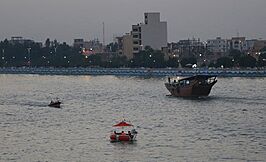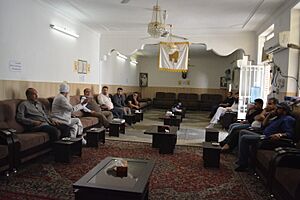Khorramshahr facts for kids
Quick facts for kids
Khorramshahr
خرَمشَهر
|
|
|---|---|
|
City
|
|
| Country | Iran |
| Province | Khuzestan |
| County | Khorramshahr |
| District | Central |
| Population
(2016)
|
|
| • Total | 133,097 |
| Time zone | UTC+3:30 (IRST) |
Khorramshahr (Persian: خرمشهر) is an important city in Khuzestan province, Iran. It is the capital of Khorramshahr County and its Central District. The city is also known as Khurramshahr or Al-Muhammerah.
Khorramshahr is a port city located about 10 kilometers north of Abadan. It sits on the right bank of the Shatt Al Arab waterway. This is where the Karun river joins the Shatt Al Arab. The city faced great damage during the Iran–Iraq War. In 1986, its population was recorded as zero. However, Khorramshahr was rebuilt after the war. Its population has now returned to what it was before the war.
Contents
History of Khorramshahr
The area where Khorramshahr is today was once covered by the waters of the Persian Gulf. Over time, it became a large area of marshlands. A small town called Piyan (later Bayan) appeared here around the first century AD. It is not certain if this town was exactly where Khorramshahr stands now.
The Haffar Canal
During the Islamic centuries, a king named Panah Khusraw Adud ad-Dawlah ordered a canal to be dug. This canal connected the Karun River to the Shatt al-Arab. The Karun River used to flow into the Persian Gulf on its own. The new canal, called the Haffar, made the Shatt al-Arab easier to navigate. The word "Haffar" means "excavated" or "dugout" in Arabic. The Haffar soon became the main channel for the Karun River, as it is today.
Khorramshahr was once the capital of the Emirate of Muhammara. Until 1847, both Persia and Turkey claimed and sometimes controlled the city. In 1847, it officially became part of Persia. This was agreed upon in the Treaty of Erzurum. At that time, an Arab sheikh ruled the city.
Impact of the Iran–Iraq War
The Iran–Iraq War had a huge impact on Khorramshahr. The city's population dropped sharply because of the conflict. In 1976, about 146,706 people lived there. By 1986, the population was recorded as zero.
After the war, people began to return and rebuild the city. By 1991, the population was 34,750. By 2006, it had grown to 123,866. In 2012, the population was estimated to be 138,398. This shows that the city has recovered and its population is now close to its pre-war levels.
People of Khorramshahr
Mandaean Community
Khorramshahr is home to a Mandaean community. Mandaeans are followers of an ancient religion. Khorramshahr is one of the few places left where the Neo-Mandaic language is still spoken. Only a few hundred people speak the Khorramshahr dialect of Neo-Mandaic.
Population Growth
Here's how Khorramshahr's population has changed over the years:
- In 2006, the city had 123,866 people living in 26,385 households.
- In 2011, the population grew to 129,418 people in 33,623 households.
- The 2016 census showed 133,097 people living in 37,124 households.
Notable People from Khorramshahr
Many notable people come from Khorramshahr:
- Majid Bishkar (born 1956) is an Iranian football legend. He played in the 1978 FIFA World Cup.
- Mohsen Chavoshi (born 1979) is a famous Iranian musician, singer, and songwriter. He has released many albums.
- Meguertitch Khan Davidkhanian (born 1902) was a former Governor.
- Abdolreza Helali (born 1981) is an Iranian Maddah, a religious singer.
- Mohsen Rastani (born 1958) is an Iranian photographer and photojournalist.
- Siamak Yassemi (born 1959) is an Iranian Mathematician. He was elected a fellow member of The World Academy of Sciences in 2018. In 2019, he received an award from France for his work in scientific cooperation.
See also
 In Spanish: Jorramchar para niños
In Spanish: Jorramchar para niños





